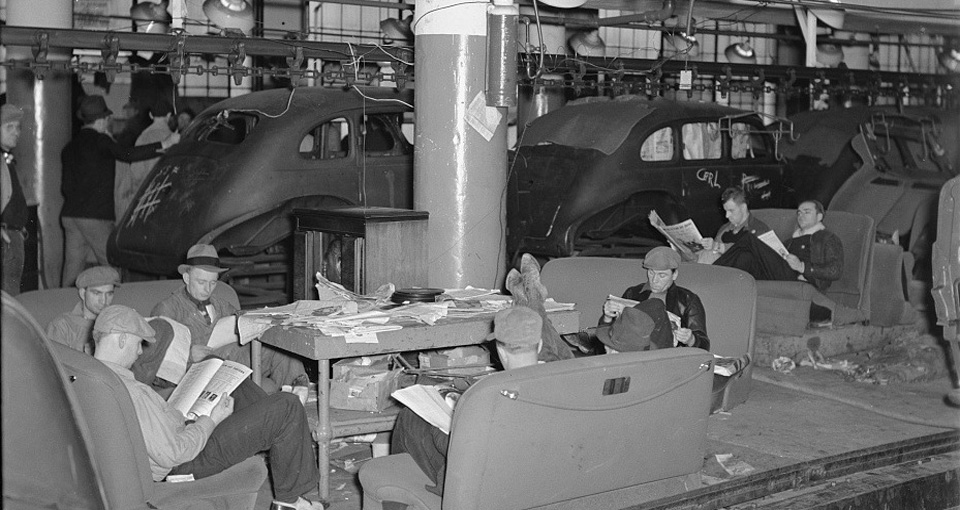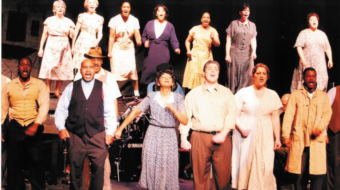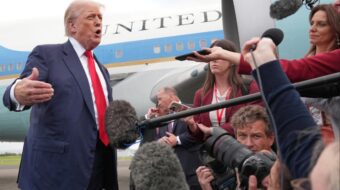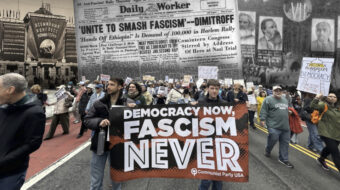
The country is about to hold the most significant election in a generation. Perhaps more. When Donald Trump rode down the escalator at Trump Plaza last year, he opened his campaign with a racist tirade against Mexican immigrants. He talked of crime and drugs, calling immigrants rapists and murderers. Hillary Clinton, by contrast, launched her campaign at the newly-constructed Four Freedoms Park, celebrating Franklin Roosevelt’s “Four Freedoms speech” of 1941: Freedom of speech, freedom of worship, freedom from want, and freedom from fear.
Clinton’s kickoff conjured a connection back to the New Deal period that has become a touchstone of American progressivism and a symbol of “activist” government in the interest of the common good. As for Trump, he recalled a mythical time when America was “great.” The contrast between the visions offered by the two couldn’t be more stark, even though both draw on some idealized notion of what America was (or was becoming) at mid-century.
That Trump has come as far as he has, knocking on the White House door, is a testimony to the power of myth. It is always easier to look back with vague nostalgia than to look forward with concrete hope. Compounded with fear, myth may sometimes win an election, but it cannot sustain a social movement of any consequence for too long. More often than not, it becomes an obstacle to moving forward.
Today’s progressives have their own version of the “great” America myth, however, centered around the New Deal period. Among liberal, even left politicos, the New Deal has become mythologized, with its memory resurrected in times of crisis. As Katrina Vanden Heuvel and Eric Schlosser wrote after the financial meltdown of 2008: “What we really need is a ‘new’ New Deal: a systematic approach to the financial and economic problems of the U.S.” The thinking is that such a “new New Deal” would reverse the trend of growing inequality and economic stagnation, curb corporate power over the nation’s political life, ensure economic growth, and restore labor’s strength.
The fact that the original New Deal was anything but “a systematic approach” to the country’s economic and social problems is forgotten. That it led to a kind of “social contract” between corporate America and labor is a popular belief that has little basis in reality. And the degree to which New Deal policies themselves can be credited with curbing inequality, reigning in corporate power, and stimulating economic growth should be questioned. For the labor movement, whose size and influence grew in this period, separating fact from fiction is crucial if it is going to pull itself out of its currently weakened state.
The real Deal
Rather than a comprehensive reform strategy, New Deal policies were a pieced-together response meant to address the economic crisis and political instability brought on by the Great Depression. In fact, as sociologist Rhonda Levine noted, “Rather than representing a coherent blueprint that…established an overall plan for economic recovery, the Roosevelt administration muddled along.”
The crisis itself was two-sided. For working people, it meant unemployment, hunger, and destitution. For capital, it was a crisis of profit accumulation and investment. Decidedly pro-business measures intended to shore-up the banking system like the Emergency Banking Act and the Glass-Steagall Act were passed as first steps. While general opinion at the time was that the economic crisis was primarily one of under-consumption, the Roosevelt administration’s initial recovery programs did not see a role for organized labor or collective bargaining to strengthen the purchasing power of workers. The inclusion of Section 7a in the National Labor Relations Act of 1935, which guaranteed workers the right to join a union, was an afterthought.
While programs like Social Security and unemployment insurance were widely popular and led to FDR’s decisive re-election in 1936, early New Deal economic policies largely failed to put Americans back to work. As labor historian David Montgomery noted in his book, Workers Control in America, “New Deal programs fed millions of needy Americans, [but] they failed miserably to restore full employment. Although the GNP had risen by 1937 to a level equal to that of 1929, the next year found 10.4 million people out of work – some 9 million more than 1929.”
The recession of 1937-8 was enough to put the New Deal on its heels. Massive layoffs depleted labor’s ranks and stalled its forward march. The recession undermined claims that the New Deal had moved the country beyond the Great Depression and helped lead to significant losses for the New Deal coalition in the mid-terms of 1938. The elections brought together a ‘conservative bloc’ of Republicans and Southern Democrats in Congress that became a bulwark for a corporate counteroffensive.
Business resisted organized labor’s new rights at every turn. What they could not achieve on a national level was pursued in the states. In 1939, Wisconsin passed the Employment Peace Act, which became a prototype of later Right-to-Work legislation. The Roosevelt administration faced a stalled economy and a reinvigorated opposition. The New Deal was on the defensive.
War recovery
With World War II looming and the New Deal stalled, the Roosevelt administration put social reform on the back burner as it sought to build consensus for wartime preparations. As it turned out, war mobilization restored the economic vitality to U.S. capitalism that New Deal policies had been unable to manage.
This also strengthened labor’s hand. War mobilization offered a patriotic mission under which unions could organize and grow. Industrial work, rather than being menial drudgery, became a patriotic act. The shared sacrifices of wartime promoted an egalitarianism that fed worker militancy. A tight labor market gave unions greater organizing and bargaining power.
While fierce conflict between labor and capital continued, especially at the beginning of the war years, organized labor’s size and strength grew in conjunction with the growth of U.S. corporate power, not at its expense. Even as business circles resisted unionization, the collective bargaining process facilitated capital accumulation, providing a stable industrial workforce and a process that ensured labor peace.
U.S. capitalism came out of the war with a strength that allowed it to adjust to, and incorporate, the demands of organized labor – especially the higher wages that were necessary to sustain the growing consumerism that was the motor of the new economy.
Labor transformed
The labor movement that came out of World War II was very different from the one that went into it. New Deal institutions offered unions a new and effective way to press their demands in contrast to the often violent and confrontational past. With labor’s legitimacy seemingly secure, trade unions embraced the political structures open to it. But this situation was far from the “social contract” between labor and capital that common belief holds today. Institutions like the NLRB and War Labor Board that were set up to oversee and enforce the new labor laws became themselves terrains of political struggle. Labor used these bodies to enlist the state in its efforts to organize and collectively bargain.
At the same time, broad sections of the business community actively sought to weaken the power of labor by isolating the collective bargaining system from political life. While unions in other countries were pushing for national health insurance programs, for instance, American unions were kept busy trying to protect the benefits of their own members. Many members viewed contract-negotiated coverage as proof of the benefits of union membership that could help make the case to non-union workers. They didn’t anticipate how that the rising cost of health coverage would become one of the principal drivers of the union-busting of the 1980’s and 90’s.
With the passage of the 1947 Taft-Hartley Act over President Truman’s veto, “the divorce of the collective bargaining system from American politics was far greater than in any other industrial democracy,” according to labor historian Nelson Lichtenstein. Class conflict had been transformed into “industrial relations.”
Breaking barriers, building walls
The early American labor movement, while having characteristics one might expect – class solidarity, collective action, militancy, and influences of the socialist movements of the time – it was also uniquely American. It took a skeptical if not hostile view of government’s role in labor-capital relations. It favored self-reliance and working class solidarity over government relief programs. More specifically, the “craft” unions were largely decentralized and upheld the deeply-imbedded “color line” of American society. Such characteristics became a liability in the changing economy of the early 20th century. The emerging mass industries required equally “mass” trade unions that would break, or at a minimum bend, the color line. It required a level of organization, centralization, and influence on government that could match that of corporate America’s.
Workers and unions often divided along ethnic and racial lines. The new industrial unions that arose in the 1930s, by contrast, became to some degree vehicles for overcoming discrimination. Among white workers, the patriotic egalitarianism of World War II broke down ethnic hierarchies. According to Lichtenstein, “one overripe fruit of the war era’s social patriotism, even of its more liberal brand of cultural pluralism, was the transformation of ethnicity into entitled whiteness.” The formation of a “white identity” coming out of the war would become sharpened as millions of mainly Black workers who had been left out of the New Deal reforms entered the industrial workforce and pressed for their rights on the job.
When the economy stalled in the 1970’s, the consolidated cohort of “white” workers became “more unified, more militant, and more determined to police its own boundaries, both at work, where seniority rights and skill definitions were highly racialized, and even more so in the new working class neighborhoods, where the defense of racial exclusivity consistently trumped laborite liberalism.”
Freed from their second-class status as “ethnic whites,” some of these workers could now be more easily won over, as full-fledged “Americans,” to the anti-union coalition of Republicans, southern Dixiecrats, and business interests in the push-back against racial integration and the social reforms of the 60’s. This development was a key component of the New Deal coalition’s unraveling.
The bubble bursts
The New Deal was a response to a particular crisis in U.S. capitalism. It adapted and reformed the state to changes and developments in U.S. capitalism’s process of production. The technological impact of the second industrial revolution, the rise of the global corporation, consumerism, and the production of consumer goods as a central focus of the economy – these changes required a state that acted as a kind of manager of political and economic life.
Whereas countries like Italy and Germany would see the rise of fascist states to fulfill this role, its expression in the U.S. was the New Deal framework. While its initial impulse was not to find a place for organized labor, the circumstances allowed and even to some degree required it – though that place was still to be one subordinate economically and politically to monopoly capital. Even in this subordinate position, the New Deal political framework and labor’s relationship with the Democratic Party gave it access to state power in a way that allowed it to benefit from the hegemonic position of U.S. capitalism in the post-WWII world. It was a position that would enable the creation of the wealthiest working class in human history.
As the post-war boom came to an end in the 60’s and profits sagged, U.S. capital increasingly came to view organized labor as the obstacle to the economic restructuring necessary to restore profitability. A common view is that labor’s embrace of “business unionism” explains its inability to counter capital’s offensive. But its not like labor didn’t put up a fight.
The union-busting associated with the neoliberal policies of the late 70’s and 80’s was the culmination, rather than the beginning, of a long corporate campaign against labor’s power in politics and the workplace. It was inaugurated as soon as the New Deal itself, and reached a fever pitch with the passage of Taft-Hartley. For American trade unions, in many ways, neoliberalism did not begin in the 70’s. Capital’s offensive against them had really never let up since the 1920’s.
The 30-year heyday of “Big Labor” was a bubble held together by the New Deal consensus and a globally-dominant U.S. economy. The successful hollowing out of New Deal institutions and the Democratic Party’s later turn from “New Dealism” to pro-market neoliberalism left labor with little leverage in political life. By the time of the de-industrialization of the 80’s and globalization of the 90’s, with trade union membership well on its way to under 20 percent of the workforce, “Big Labor’s” bubble had burst.
Solidarity sometimes
One important factor that would inevitably impact efforts at any “new” New Deal is the strength of today’s labor movement. Many in labor’s ranks justifiably bemoan its shrinking numbers. But apart from the post-war period, when it peaked around 30 percent, union membership in the U.S. has mostly fluctuated in the single digits and teens. Density grew to around 12 percent in 1920 before the business-led American Plan and Red Scare repression. In spite of its size, labor was still able to win passage of the Anti-Injunction Act of 1932 and the Wagner Act of 1935, the central piece of New Deal Labor legislation.
There is an important distinction between today’s small labor movement and the pre-New Deal one, and it is not simply the absence of a vibrant left in its ranks. The process of producing goods and services has changed.
Automation, globalization, and de-industrialization have fragmented production geographically, complicating labor’s ability to exert power at “the point of production.” But that alone does not fully explain labor’s diminished power. And new organizational forms alone, even those adapted to this new economy, are not enough to restore it.
The New Deal’s National Labor Relations Act of 1935 institutionalized the employer/worker relationship, contributing to the growth of unions. At the same time, it established limits on labor’s ability to strike, boycott, and take other industrial actions that restricted the “free flow of goods.” Solidarity actions were a significant source of worker power. Taft-Hartley significantly expanded these limits and stabbed at the heart of working class identity and power – the (unrecognized) right to come together in acts of solidarity with each other.
While the New Deal consensus held and the economy was strong, such limitations might be easily overlooked, but with the rise of neoliberalism and the collusion of government with corporate power, they are a body blow. In our globalized economy, worker solidarity across nations is an obvious and pressing need, but what is a labor movement if it can’t even stand in solidarity with the workers across town, or in a neighboring state?
What’s the Deal?
The New Deal framework can be credited with enabling the many gains made by American workers at the time, but it was contingent on specific circumstances – in particular, U.S. dominance in the world after WWII and the emergence of consumerism as a driving force in the economy. But the New Deal remained incomplete.
As a concession to the white Southern land aristocracy, it also left out millions of agricultural and domestic workers, who conveniently just happened to be Black. It was a concession without which the New Deal never would have happened.
So what kind of “Deal” should labor and the left push for today? Labor law should protect all workers, especially contingent and part-time ones. Technology is increasingly putting the shorter work week on the agenda as the only realistic way to address chronic unemployment on the one side, an overworked workforce on the other, and the recognition that we live on a finite planet. Why such a demand is absent from labor’s agenda needs to be understood.
The anti-labor restrictions of the Taft-Hartley Act need to be overturned. President Truman, in his unsuccessful veto, described the Act as a “dangerous intrusion on free speech” and in “conflict with important principles of our democratic society.” The state of labor today is a consequence of this democratic shortcoming.
Economic growth remains at historically low levels. How U.S. capitalism’s position globally will affect its attitude toward U.S. workers as the neoliberal project unravels is hard to predict. Chances are it will be mixed. Recently, in a deal with union autoworkers in Canada, General Motors agreed to move the jobs that are now manufacturing an engine in Mexico to Canada. The caveat? The union agreed to give up its defined pension plan for one that fluctuates with the market.
Increasingly, U.S. unions will have to grapple with the fact that its defined benefits of health coverage and retirement will be nearly impossible to achieve through contract negotiation, whether for current members or the newly organized. Rather, they will have to be sought on a society-wide level through social action.
How will U.S. capitalism respond? While dominant, U.S. capitalism’s relationship to the rest of the world is, as they say, complicated. Europe, Japan, and the United States have complimentary and competing interests within their political alliance. Russia and China, meanwhile, pursue autonomous projects within the context of global capitalism. Add to that the growth of the middle classes in countries like Brazil, South Africa, India and, of course, the behemoth China, and the role of the American market in U.S. capitalism’s political and economic calculations is changing. It must respond to, shape, and develop not only the U.S. market, but those of other countries as well.
The isolationism and xenophobia of the GOP presidential candidate Donald Trump not withstanding, the viability of U.S. capitalism overall depends on its ability to respond and influence an increasingly more connected world. Organized labor’s viability depends on that ability as well.
The 80-year-old New Deal story offers many important lessons for U.S. workers – lessons often obscured by the story itself. Going forward, as the saying goes, you can’t step in the same river twice. When it comes to a new “Deal,” the same holds true.










